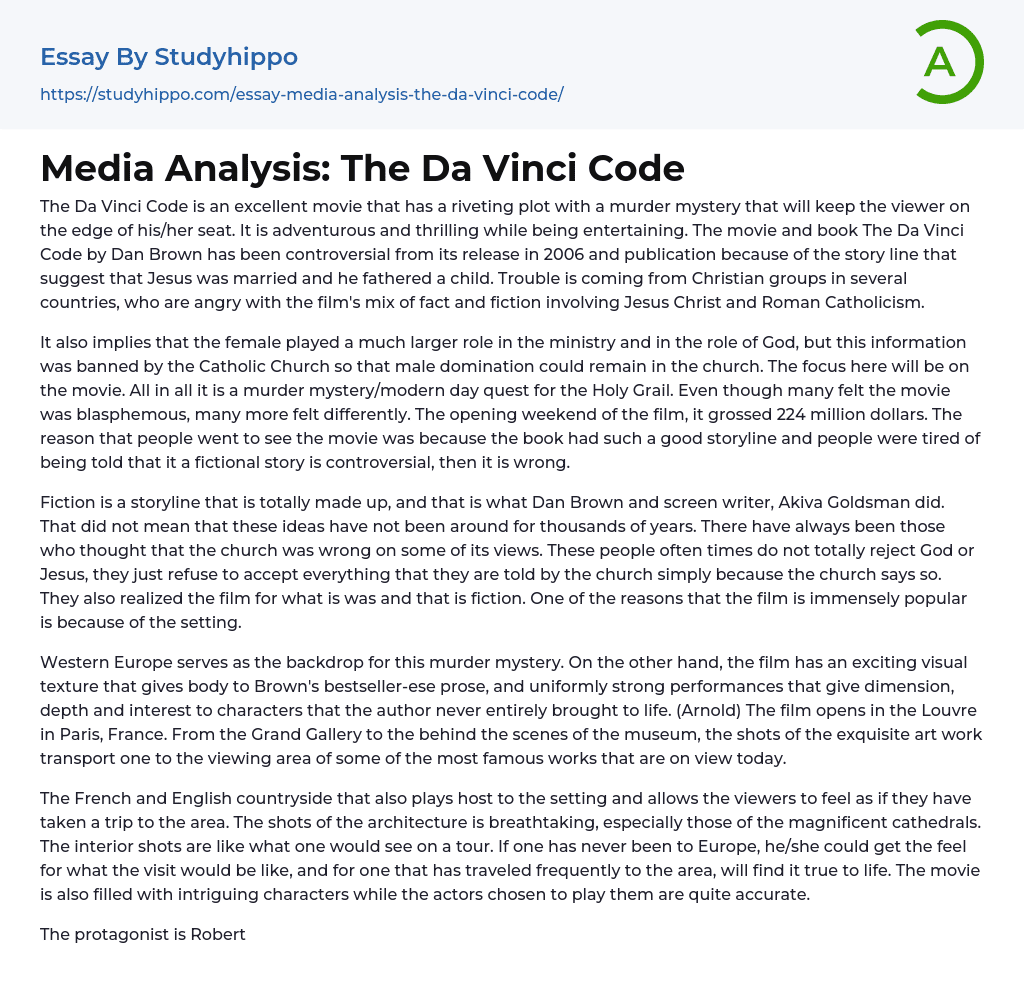The Da Vinci Code, released in 2006, is a captivating and enjoyable movie with an intriguing plot and murder mystery that will engross viewers. It has generated controversy due to its suggestion that Jesus was married and had a child, which has upset Christian organizations worldwide. Both the movie and book adaptations of Dan Brown's The Da Vinci Code have received criticism for their combination of truth and fiction regarding Jesus Christ and Roman Catholicism.
The text reveals that the Catholic Church suppressed information about women's significant role in God's ministry to uphold male dominance within the church. The discussion centers on a movie that merges murder mystery with a modern search for the Holy Grail. Although some considered it sacrilegious, the majority had a different perspective. The film generated an impressive $224 million in its opening weekend as audiences wer
...e fascinated by its captivating plot and determined to challenge the idea that controversial fictional stories are inherently immoral.
Fiction is an entirely fabricated narrative, and that is exactly what Dan Brown and screenwriter Akiva Goldsman accomplished. Nevertheless, these concepts have been present for many centuries. Numerous individuals have held the belief that certain teachings of the church are incorrect. These people do not necessarily completely dismiss God or Jesus; instead, they critically examine everything the church presents to them without unquestioningly embracing it. They also acknowledge that the mentioned film is a work of fiction. The film's captivating setting partially accounts for its widespread appeal.
The movie adaptation of the murder mystery is set in the Louvre museum in Paris, France. It effectively captures Brown's bestselling prose visually an
brings the characters to life through impressive performances. The film showcases the magnificent artwork displayed in the Grand Gallery and offers a glimpse behind-the-scenes at the museum, allowing viewers to fully immerse themselves in witnessing some of the world's most famous works currently on exhibit.
The film takes viewers to the French and English countryside, providing a genuine sense of being present. The stunning shots of architectural wonders, particularly cathedrals, have a profound effect. The interior scenes resemble those encountered during a guided tour. Regardless of one's familiarity with Europe, the film captures an authentic ambiance. Furthermore, it presents captivating characters portrayed convincingly by talented actors.
Tom Hanks portrays Robert Langdon, a central character renowned for his skill in decoding symbols. In Paris, Langdon is summoned to decipher a cryptic message left by a deceased curator at a museum. Engaged in an perilous plot, Langdon risks his own life to uncover the truth regarding the church and murder. Hanks effectively brings Langdon to life as both an esteemed professor and accomplished author. The role was not assigned to a young and attractive Hollywood actor lacking acting abilities.
Hanks is a versatile actor with talent in various genres, from comedy to drama, making him an ideal choice for the role. In contrast, Tautou, a French actress, was selected to portray Sophie Neveu, the co-protagonist and granddaughter of the murdered curator who acts as a detective. Eventually, she unveils her direct lineage from Jesus. The decision to cast Tautou as Sophie was wise due to her character's credibility in having such a profound connection with Jesus.
The film showcases talented actors, including Ian
McKellen, Jean Reno, and Paul Bettany. They skillfully portray the captivating characters in the story. Alfred Molina, renowned for his outstanding performances, is ideally suited to play Bishop Manuel Aringarosa. He leads a Catholic sect called Opus Dei. Bishop Aringarosa (Alfred Molina) embodies the character of King Herod and represents the hierarchy of the Catholic Church, which includes the Pope (Lanzana).
The addition of Opus Dei to the plot increased the intrigue of the story. This small and faithful sect remains a mystery to the world, making the movie clever. Even those who will never witness the inner workings of the group were given a glimpse into their world. Furthermore, the movie included numerous details about the Priory of Sion, a secret society that has captivated minds for centuries. While the portrayal of these groups in the movie may be fictional, it upset them nonetheless.
Many people have been portrayed unflatteringly in the media, but it's important to remember that movies are a form of art. Therefore, viewers should approach them as they would any fictional story. The Da Vinci Code was a noteworthy film that introduced much-needed art and cultural history to individuals living in a society that typically neglects such subjects. Additionally, it offered entertainment value by engaging the mind and providing a diversion from everyday life. Although it may not become a cinematic classic, it is nonetheless a film worth watching.
- Adam And Eve essays
- Baptism essays
- Catholic Church essays
- Christian essays
- Church essays
- Crucifixion Of Jesus essays
- Crusades essays
- Elizabeth essays
- Eucharist essays
- God The Father essays
- Holy Spirit essays
- Jesus Christ essays
- Lord essays
- Pope essays
- Priest essays
- Protestant Reformation essays
- Protestantism essays
- Sacrament essays
- Collaboration essays
- Dialogue essays
- Fake News essays
- Journalism essays
- Mass Media essays
- Media Analysis essays
- Media Bias essays
- Media Studies essays
- Message essays
- News essays
- Propaganda essays
- Radio essays
- Rogerian Argument essays
- Role of Media essays
- Social Media essays
- Social Media Marketing essays
- Social Networking essays
- Youtube essays




